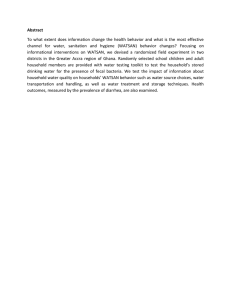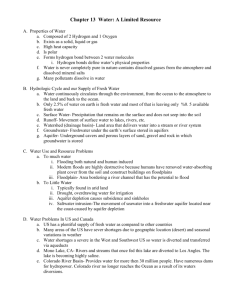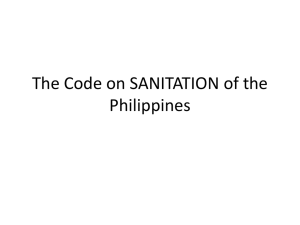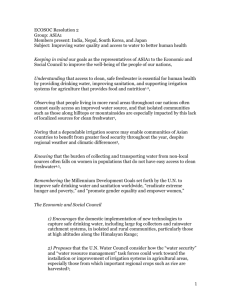Exploring the trade-offs between irrigation and drinking water supply under... water system in Ethiopia
advertisement
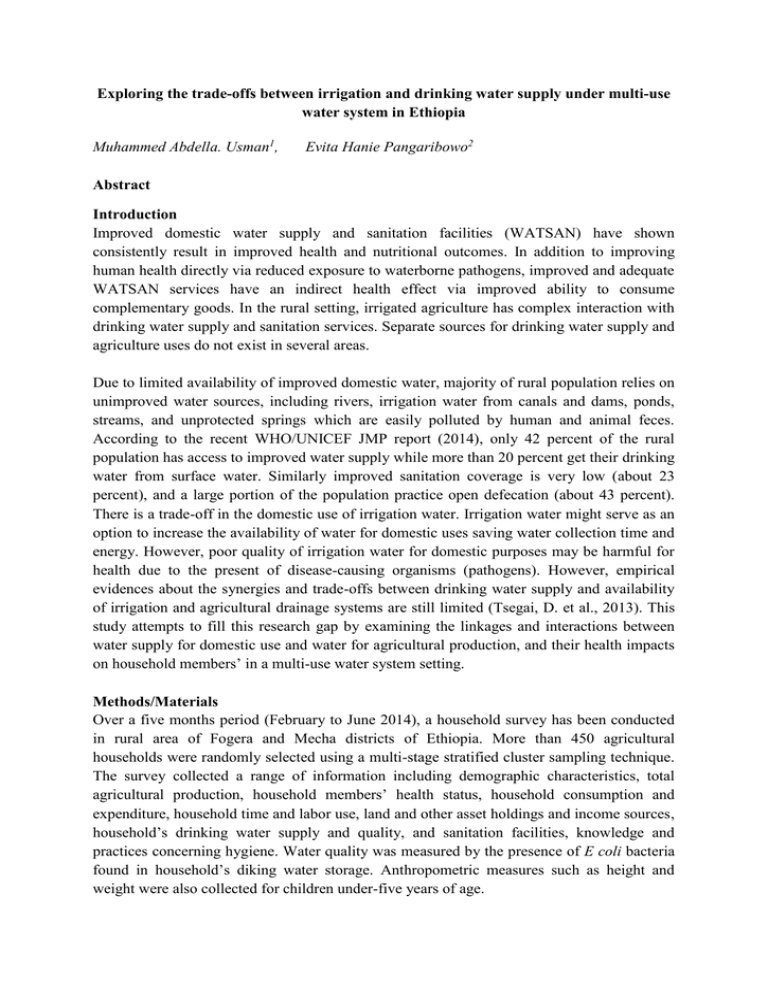
Exploring the trade-offs between irrigation and drinking water supply under multi-use water system in Ethiopia Muhammed Abdella. Usman1, Evita Hanie Pangaribowo2 Abstract Introduction Improved domestic water supply and sanitation facilities (WATSAN) have shown consistently result in improved health and nutritional outcomes. In addition to improving human health directly via reduced exposure to waterborne pathogens, improved and adequate WATSAN services have an indirect health effect via improved ability to consume complementary goods. In the rural setting, irrigated agriculture has complex interaction with drinking water supply and sanitation services. Separate sources for drinking water supply and agriculture uses do not exist in several areas. Due to limited availability of improved domestic water, majority of rural population relies on unimproved water sources, including rivers, irrigation water from canals and dams, ponds, streams, and unprotected springs which are easily polluted by human and animal feces. According to the recent WHO/UNICEF JMP report (2014), only 42 percent of the rural population has access to improved water supply while more than 20 percent get their drinking water from surface water. Similarly improved sanitation coverage is very low (about 23 percent), and a large portion of the population practice open defecation (about 43 percent). There is a trade-off in the domestic use of irrigation water. Irrigation water might serve as an option to increase the availability of water for domestic uses saving water collection time and energy. However, poor quality of irrigation water for domestic purposes may be harmful for health due to the present of disease-causing organisms (pathogens). However, empirical evidences about the synergies and trade-offs between drinking water supply and availability of irrigation and agricultural drainage systems are still limited (Tsegai, D. et al., 2013). This study attempts to fill this research gap by examining the linkages and interactions between water supply for domestic use and water for agricultural production, and their health impacts on household members’ in a multi-use water system setting. Methods/Materials Over a five months period (February to June 2014), a household survey has been conducted in rural area of Fogera and Mecha districts of Ethiopia. More than 450 agricultural households were randomly selected using a multi-stage stratified cluster sampling technique. The survey collected a range of information including demographic characteristics, total agricultural production, household members’ health status, household consumption and expenditure, household time and labor use, land and other asset holdings and income sources, household’s drinking water supply and quality, and sanitation facilities, knowledge and practices concerning hygiene. Water quality was measured by the presence of E coli bacteria found in household’s diking water storage. Anthropometric measures such as height and weight were also collected for children under-five years of age. Follow up survey were administered subsequently every two weeks for three months to record the prevalence of diarrhea and fever of children under five of the respective interviewed households. Child health statuses as measured by prevalence of diarrhea, fever, and anthropometric indicators (weight-for-age, height-for-age) are the outcome variables. Econometrics methods will be used such as endogenous switching regression and propensity score matching to examine the health benefits of improved WATSAN. Preliminary Results and Discussions The preliminary result shows that 66 percent of the sample households practice irrigation farming. Over 49 percent of our sample households have access to improved water supply, while the percentage of households with positive E coli at household drinking water storage is about 58 percent. Open defecation practice is about 59 percent. The self-reported prevalence of diarrhea diseases for children of under five years of age is about 16 percent. The prevalence of underweight and stunting based on the anthropometric measurement results for under five children is 27 and 41 percent respectively. On average, households practicing irrigation farming are wealthier than households using conventional farming system (rain feed agriculture). There is also a significant difference in open defecation practice between irrigating and non-irrigating villages) Conclusion/Expected results The expected findings of the research, in addition to filling the research gap in the empirical literature, it would also provide key inputs for policy makers to design evidence based water supply and sanitation intervention policies. Such intervention would likely be effective and sustainable to ensure quality provision of WATSAN services through the full engagement of all the sectors and actors, and building the capacities of the communities to maintain and manage their WATSAN environment locally. The study is pioneer in this area by investing the linkage among WATSAN, health and irrigation agriculture using state-of-the art econometric methods. Mostly, previous empirical works focus on the relationship either between WATSAN and health or irrigation and health while isolating the complex interaction among irrigation agriculture, health and WATSAN environments. 1 Muhammed Abdella Usman Department of Economic and Technological Change Center for Development Research (ZEF) University of Bonn Walter-Flex-Str. 3 53113 Bonn Germany Phone: +49(0)228 73-1852 E-Mail: mabdella@uni-bonn.de 2 Evita Hanie Pangaribowo Department of Economic and Technological Change Center for Development Research (ZEF) University of Bonn Walter-Flex Str. 3 53113 Bonn Germany Phone: +49 (0)228 73-1823 E-Mail: evita.pangaribowo@uni-bonn.de References 1. Tsegai, D.W., McBain, F., & Tischbein, B. (2013) Water, sanitation ad hygiene: The missing link with agriculture. ZEF Working Paper Series (No. 107), 1-38 2. WHO/UNICEF JMP. (2014) Progress on Drinking Water and Sanitation: 2014 Update. New York, NY, USA, United Nations Children’s Fund; Geneva, Switzerland, World Health Organization
